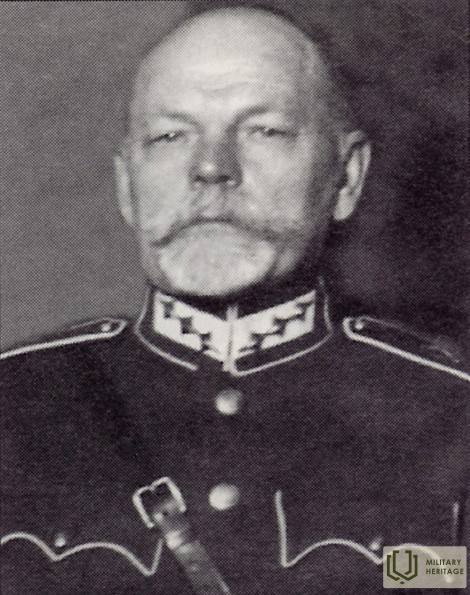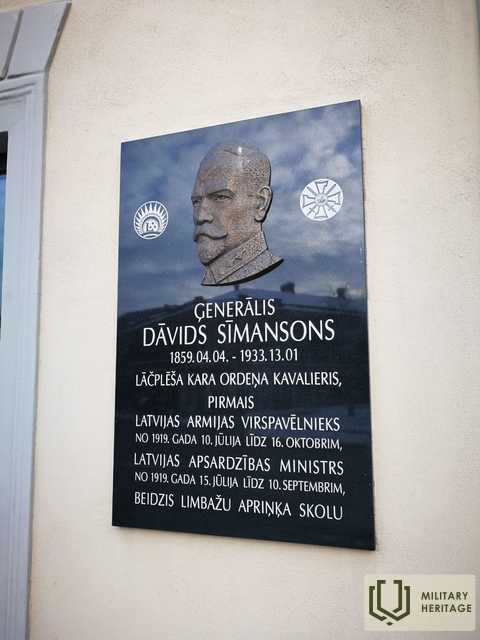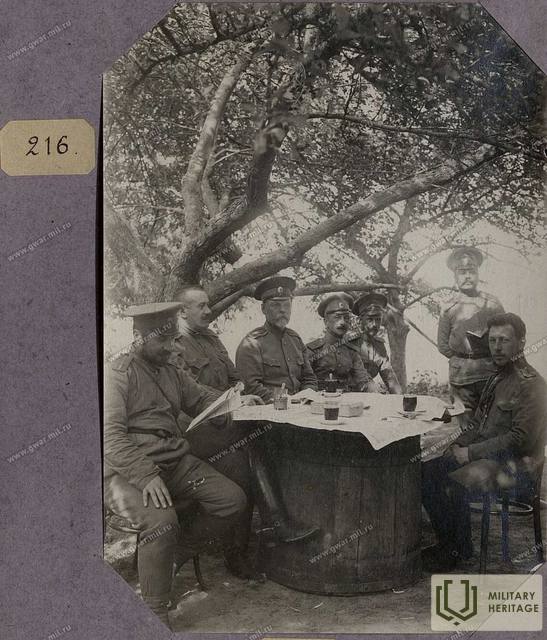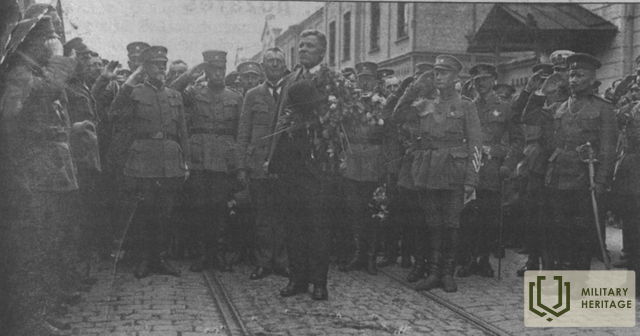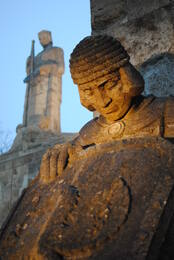Apie pirmąjį Latvijos armijos vyriausiąjį vadą Dāvidą Sīmansoną
Knygos „Latvijos armijos vadai“ esė įtikina, kad istorijai didelę įtaką daro konkretūs asmenys. Nors svarbiausių istorinių įvykių epicentre jie buvo trumpą laiką, tikri Latvijos patriotai, turėdami didelę karinę patirtį, sugebėjo daug nuveikti formuojant ir stiprinant Latvijos kariuomenę bei istorinių įvykių lūžio taškuose.
Ši istorija yra apie pirmąjį Latvijos armijos vyriausiąjį vadą Dāvidą Sīmansoną (1859–1933).
Dāvidas Sīmansonsas gimė 1859 m. balandžio 4 d. Pilatuose, Valmieros valsčiuje. Jis baigė Limbažių rajono mokyklą. 1880 m. savanoriškai įstojo į kariuomenę, 115-ajame pėstininkų pulke. 1881 m. D. Sīmansonsas įstojo į Rygos junkerių mokyklą, kurią baigė 1883 m. kaip leitenantas. 1888 m. jam buvo suteiktas antrojo leitenanto laipsnis. 1891 m. jis įstojo į Generalinio štabo akademiją. 1892 m. D. Sīmansonsas gavo leitenanto laipsnį, po kurio sekė štabo kapitono (1899 m.), kapitono (1901 m.) ir pulkininko leitenanto (1904 m. kovo mėn.) laipsniai.
1904–1905 m. D. Sīmansonsas dalyvavo Rusijos-Japonijos kare; 1910–1912 m. jis buvo vyresnysis štabo karininkas. 1910 m. jam buvo suteiktas pulkininko laipsnis, o 1915 m. gegužę – generolo majoro laipsnis. Iki 1917 m. pabaigos D. Sīmansonsas vadovavo įvairiems armijos daliniams – 116-ojo pėstininkų pulko batalionui, 66-ajam pėstininkų pulkui, 17-ajai divizijos brigadai, Kalugos atskirai brigadai, 135-ajai divizijai ir 4-ajai atskirai divizijai. Jis taip pat buvo kelis kartus sužeistas mūšiuose. 1917 m. spalį D. Sīmansonsas paliko tarnybą ir 1919 m. sausį grįžo į Rygą. 1919 m. birželio 6 d. D. Sīmansonsas, jau būdamas generolu, įstojo į Latvijos laikinosios vyriausybės ginkluotąsias pajėgas, 1-ąją Latvijos atskirąją brigadą.
Oskaro Kalpo (1882–1919) darbą tiesiogiai tęsė pulkininkas leitenantas Jānis Balodis (1881–1965), kuris 1919 m. balandžio mėn. Kalpako bataliono pagrindu įkūrė 1-ąją Latvijos atskirąją brigadą, kuri, kaip ir O. Kalpako batalionas, buvo pavaldus Vokietijos Landesvero vyriausiajai vadovybei. Todėl Latvijos armijos formavimas prasidėjo tik 1919 m. liepos 10 d., sujungus 1-ąją Latvijos atskirąją brigadą ir Jorgio Zemitano (1873–1928) vadovaujamą Šiaurės Latvijos brigadą. Pirmuoju vyriausiuoju vadu buvo paskirtas iš Rusijos atvykęs generolas Dāvids Sīmansons, kuris nebuvo tarnavęs Latvijos pulkuose ir kurio veikla Latvijos visuomenei buvo mažiau žinoma.
Tuo pačiu metu, nuo liepos 15 d. iki rugsėjo 5 d., jis buvo ir Laikinosios vyriausybės, kurią patvirtino Liaudies taryba, pertvarkyta ir papildyta kai kuriais mažumų atstovais, saugumo ministras.
Tuometinis Vyriausiojo armijos vado štabo Spaudos skyriaus viršininkas – kapitonas Aleksandras Plensneris – rašė, kad į vyriausiojo vado pareigas jis daugiausia buvo pasirinktas kaip kompromisinė figūra, kad jam nereikėtų rinktis tarp J. Zemitano ir J. Baložo, kilus prieštaravimams tarp vadinamųjų „šiauriečių“ ir „pietų“ po Cėsių mūšio, kuriame J. Baložo vadovaujama brigada nedalyvavo ir nesilaikė neutralumo.
Plesneris apie savo įspūdžius rašė: „[...] Jam jau buvo 60 metų – mano suvokimu, tai buvo didelis amžius, bet aš jo per daug nejaučiau. Man atrodo, kad jis gerai reprezentavo Rusijos reguliariojo generolo tipą. Su kardo diržu ant pastebimo pilvo. Tačiau dėmesingas ir malonus žmonėms, kad ir kas jie būtų. Man apie jį liko geras įspūdis. Žinoma, jis pateko į visiškai kitokią atmosferą ir visiškai kitokią armiją, nei tarnavo anksčiau. Iš ankstesnio požiūrio taško jis dabar tapo sukilėlių vadu. Atrodė, kad ši užduotis jam nepatiko. Tiesiog ji jam vis dar buvo nauja ir neįprasta. Jis turėjo prie to priprasti. Ir jis bandė tai daryti su pastebimu noru suprasti. Atrodo, kad jame dar nebuvo išdžiūvęs latvių kraujas.“
Šiuo sunkiu metu vyriausiajam vadui teko spręsti įvairius su naujosios armijos egzistavimu susijusius klausimus – degalų, medicinos ir politinius klausimus.
Vyriausiojo vado darbo ypatumus apibūdina ir tai, kad pradžioje buvo tam tikrų neaiškumų dėl pulkų numeracijos. Jie atspindėjo konkurenciją tarp Latvijos armijos karininkų grupių, jau minėtų vadinamųjų „šiauriečių“ ir „pietų“.
Rugpjūčio pabaigoje vyriausiasis vadas Deividas Simonsonas dalyvavo Rygoje vykusiame antiteroristinių pajėgų atstovų susitikime, kuriame Lenkijos karinis atstovas Aleksandras Miškovskis nurodė tikruosius Bermonto ketinimus. Iškart po to, rugpjūčio 30 d., Simonsonas pateikė atsistatydinimo pareiškimą iš karo ministro pareigų, „nes jis nori būti tik vyriausiuoju armijos vadu, kadangi kol kas prisiėmė tik karo ministro pareigas“.
Matyt, brendo Bermonto kariuomenės krizė; spalio pradžioje vyriausybei ir armijos vadovybei jau buvo aišku, kad kils konfliktas.
Spalio 6 d. vyriausiasis armijos vadas D. Sīmansonsas užšifruota telegrama įgaliojo karinį atstovą Mārtinį Hartmanį prašyti Lenkijos armijos vadovybės pradėti karo veiksmus prieš Bermonto dalinius, kurie „žygiavo iš Kuršo ir Lietuvos“ šiaurės rytų kryptimi. Spalio 8 d. Bermonto pajėgos pradėjo Rygos puolimą.
Jau spalio 11 d. Gynybos ministerijoje įvyko vyriausiojo vado D. Sīmansono ir Prancūzijos bei Didžiosios Britanijos misijų vadovų susitikimas dėl Bermonto raginimo sudaryti paliaubas ir susitarti dėl bendrų veiksmų prieš Raudonąją armiją. Nuomonės išsiskyrė, o atsakymas nebuvo išsiųstas iš karto. D. Sīmansonas atsisakė tik po kelių dienų. Spalio 14–15 d. Latgalos divizijos dalys pradėjo puolimą per Dauguvos tiltus, patirdamos didelių nuostolių, o tuo pačiu metu, remiant sąjungininkų flotilės artilerijai, buvo užimtos Daugavgryvos ir Bolderajos.
1926 m. D. Sīmansonsui buvo įteiktas Lačplėsio karo 3-iojo laipsnio ordinas už tai, kad spalio 9–10 d. „savo protingais ir energingais veiksmais išgelbėjo kareivius nuo pavojaus, perkėlė visus mūsų dalinius į dešinįjį Dauguvos krantą, nepalikdamas priešui jokių trofėjų. Nesavanaudiškais veiksmais jis atlaikė visus priešo smūgius ir labai greitai pradėjo puolimą, kurio metu buvo išlaisvinti Daugavgrīva ir Bolderaja, o tai didele dalimi prisidėjo prie visos Rygos išlaisvinimo“.
Spalio 15 d. D. Sīmansonsas pateikė vyriausybei prašymą paleisti jį į laisvę. Nesėkmės Bermonto puolimo pradžioje pasirodė esančios per sunkios jo sveikatai.
Kitą dieną jis buvo įtrauktas į atsargą. Plensneris pripažino, kad Simansonsas buvo pašauktas trauktis. Nusprendęs priešintis ir nubausti Zemitaną už įsakymą trauktis iš Rygos, jis elgėsi priešingai vyriausybės, kuri norėjo apsaugoti miestą, ketinimams.
Zemitanas buvo išdavęs įsakymą atsistatydinti Ulmanio įsakymu. Tai netiesiogiai patvirtina faktas, kad užsienio reikalų ministras Zigfrīds Ana Meierovicas, išvykdamas į Lenkiją, jau spalio 14 d. pasiūlė Balodiui vyriausiojo vado pareigas, taip pat tai, kad spalio 17 d., Balodžiui atvykus į Rygą, Sīmansonsas, matyt, įsižeidęs ir, nurodydamas ligą, nepasirodė štabe perduoti pareigų.
Istorikas Edgaras Andersonas mano, kad Sīmansoną Ulmanio iniciatyva pakeitė Balodis. Pažymėtina, kad Bermontui išvarius iš Latvijos, Ulmanis dar kartą padėkojo Sīmansonui „už armijos organizavimo darbą, kurį pradėjo generolas ir kuris dabar baigiamas“.
Nuo 1920 m. gruodžio mėn. Sīmansonsas buvo Gynybos (Karo) ministerijos tarybos narys, o nuo 1924 m. – laikinai ėjo Tarybos pirmininko pareigas.
1921 m. pabaigoje tuometinis Karo tarybos pirmininkas Kārlis Goppers savo atestacijoje rašė: „Švari sąžinė ir aiškūs principai neleidžia jam užsiciklinti ties dabartinėmis neišspręstomis aplinkybėmis, kurios jį dažnai liūdina ir neramina. Didelis pasiaukojimas kare atsiliepė jo sveikatai, kuri nebeleidžia jam ugdyti energijos ir ištvermės darbe, prie kurių jis yra įpratęs.“
1925 m. vasarį Sīmansonsas buvo išleistas atostogų. 1930 m. vasarą spauda rašė: „Saulėtomis dienomis Esplanados alėjose ar Vērmanos sodo žalumoje galima sutikti seną kareivį su generolo uniforma. Remdamasis lazda, jis žengia kiekvieną žingsnį, tarsi nešdamas savo ilgo gyvenimo ir metų kareivio tarnystėje naštą. Daugelis nė nenutuokia, kad šis senolis yra vyriausias Latvijos kareivis ir kartu vyriausias mūsų generolas.“
Deividas Simonsonsas mirė 1933 m. sausio 13 d. Rygos karo ligoninėje, į kurią buvo paguldytas dar 1932 m. pabaigoje. Generolas buvo išvežtas iš Rygos katedros ir su karine pagarba palaidotas Brolių kapinėse šalia „Motinos Latvijos“ statulos.
2013 metais Limbažuose, prie buvusio miesto tarybos pastato fasado (Baumaņa Kārļa laukums 1), buvo įrengta atminimo lenta D. Sīmansonui.
Per savo karinę karjerą D. Sīmansonsas buvo apdovanotas Latvijos 3-iojo laipsnio Lačplėšio karo ordinu, Gynėjų nuopelnų kryžiumi; Rusijos Šv. Jurgio kardu, 3-iojo ir 4-ojo laipsnio Šv. Vladimiro ordinais, 2-ojo ir 3-iojo laipsnio Šv. Stanislovo ordinais, 3-iojo laipsnio Šv. Onos ordinu.
„Latvijos armijos vadai“, leidykla „Jumava“, 2018 m.
Susijusi laiko juosta
Susijusios temos
Susijusios vietos
Sudrabkalninio kalnas – memorialas kovai su Bermonto armija
Įsikūręs Rygoje, Pārdaugavoje, Sloko ir Kurzemes prospektų sankirtoje.
1919 m. lapkričio pradžioje, per Latvijos nepriklausomybės karus, Pardaugavoje vyko gatvių mūšiai tarp Latvijos armijos ir Bermonto kariuomenės. Lemiamas puolimas prieš Bermonto armiją įvyko šioje vietovėje. 1937 m. Sudrabkalninyje pagal Kārlio Zālės projektą buvo atidengtas paminklas, pagerbiantis žuvusius 6-ojo Rygos pėstininkų pulko karius ir pabrėžiantis jų karines savybes.
Sukurta kaip memorialinė siena – simbolinis įtvirtinimas, kurio vartuose pavaizduotas liūtas, blokuojantis kelią priešo puolimui. Pastatyta iš Daugavgryvos tvirtovės gynybinio pylimo akmeninių blokų ir iškalta iš Laisvės paminklo likusio granito. Memorialinės vietos kaina siekė beveik 35 000 latų. Palyginimui, už šią sumą buvo galima įsigyti 4 Latvijoje pagamintus „Ford - Shield V8 De Luxe“ automobilius.
Šiandien galite aplankyti vieną įspūdingiausių Nepriklausomybės kovų memorialų.
Brolių kapinės Rygoje
Rygos brolių kapinės yra šiauriniame Rygos rajone. Kapinės užima 9 ha plotą ir yra iškiliausias bei reikšmingiausias memorialinis ansamblis Latvijoje, skirtas žuvusiems Latvijos kariams. Čia palaidota apie 3000 karių. Brolių kapinės buvo įkurtos Pirmojo pasaulinio karo metu, palaidojus pirmuosius tris Latvijos šaulius, žuvusius Tyrelio purve mūšyje prieš vokiečių armiją. Vėliau Brolių kapinėse taip pat buvo palaidoti Latvijos kariai, žuvę kituose mūšiuose ir karuose. Memorialas sukurtas pagal skulptoriaus Kārlio Zālės projektą ir yra pirmasis memorialinis ansamblis Europoje, turintis tokią kraštovaizdžio, architektūros ir skulptūrinę vertę. Jame naudojami Latvijos kraštovaizdžiui būdingi elementai, tradicinės sodybos, Latvijos folkloras ir istorija, kurie giria karių savybes ir pasakoja apie kario kelią. Memorialas buvo atidengtas 1936 m. ir jį sudaro trys dalys: „Minties kelias“ – 250 m ilgio alėja, „Didvyrių terasa“ su Šventosios liepsnos aukuru ir Šventosios ąžuolyno ansambliu bei laidojimo vieta su Latvijos siena ir motinos su žuvusiais sūnumis memorialu.




